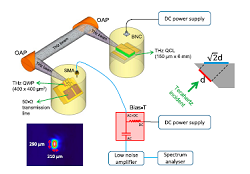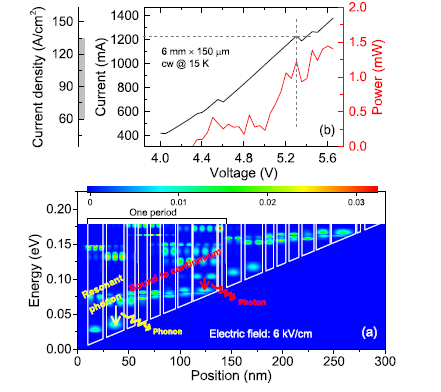-
6.2-GHz modulated terahertz light detection using fast terahertz quantum well photodetectors
The fast detection of terahertz radiation is of great importance for various applications such as fast imaging, high speed communications, and spectroscopy. Most commercial products capable of sensitively responding the terahertz radiation are thermal detectors, i.e., pyroelectric sensors and bolometers. This class of terahertz detectors is normally characterized by low modulation frequency (dozens or hundreds of Hz). Here we demonstrate the first fast semiconductor-based terahertz quantum well photodetectors by carefully designing the device structure and microwave transmission line for high frequency signal extraction. Modulation response bandwidth of gigahertz level is obtained. As an example, the 6.2-GHz modulated terahertz light emitted from a Fabry-Pérot terahertz quantum cascade laser is successfully detected using the fast terahertz quantum well photodetector.
-
Homogeneous spectral spanning of terahertz semiconductor lasers with radio frequency modulation
Homogeneous broadband and electrically pumped semiconductor radiation sources emitting in the terahertz regime are highly desirable for various applications, including spectroscopy, chemical sensing, and gas identification. In the frequency range between 1 and 5 THz, unipolar quantum cascade lasers employing electron inter-subband transitions in multiple-quantum-well structures are the most powerful semiconductor light sources. However, these devices are normally characterized by either a narrow emission spectrum due to the narrow gain bandwidth of the inter-subband optical transitions or an inhomogeneous broad terahertz spectrum from lasers with heterogeneous stacks of active regions. Here, we report the demonstration of homogeneous spectral spanning of long-cavity terahertz semiconductor quantum cascade lasers based on a bound-to-continuum and resonant phonon design under radio frequency modulation.
-
Nanoscale distribution of Bi atoms in InP1-xBix
The nanoscale distribution of Bi in InPBi is determined by atom probe tomography and transmission electron microscopy. The distribution of Bi atoms is not uniform both along the growth direction and within the film plane. A statistically high Bi-content region is observed at the bottom of the InPBi layer close to the InPBi/InP interface. Bi-rich V-shaped walls on the (-111) and (1–11) planes close to the InPBi/InP interface and quasi-periodic Bi-rich nanowalls in the (1–10) plane with a periodicity of about 100 nm are observed. A growth model is proposed to explain the formation of these unique Bi-related nanoscale features. These features can significantly affect the deep levels of the InPBi epilayer. The regions in the InPBi layer with or without these Bi-related nanostructures exhibit different optical properties.
-
A W-Band Traveling-Wave Frequency Doubler With Output Power of 9 dBm and Power Efficiency of 11.2%
Abstract—An 85 to 110 GHz high efficiency, high output power frequency doubler is presented in this letter. The traveling-wave topology is used to generate even harmonics and suppress odd harmonics effectively. The output fundamental and 4th harmonic reflectors are applied to enhance the efficiency, conversion gain and fundamental rejection. The measured results show a peak conversion gain of 3.2 dB and peak efficiency of 11.2% with a saturated output power of 9 dBm at 100 GHz. The doubler exhibits higher than 30 dB fundamental rejection from 85 to 110 GHz with a compact chip size of 1.5 0.9 mm .
-
Optical-phonon-mediated photocurrent in terahertz quantum-well photodetectors
Strong and sharp photocurrent peak at longitudinal optical (LO) phonon frequency (8.87 THz) is found in GaAs/(Al,Ga)As terahertz quantum-well photodetectors (QWPs). Two mesa-structure terahertz QWPs with and without one-dimensional metal grating are fabricated to investigate the behavior of such photoresponse peak. The experimental and simulation results indicate that the photocurrent peak originates from a two-step process. First, at the LO phonon frequency, a large number of non-equilibrium LO phonons are excited by the incident electromagnetic field, and the electromagnetic energy is localized and enhanced in the thin multi-quantum-well layer. Second, through the Frohlich interaction, the localized electrons are excited to continuum states by absorbing the non-equilibrium LO phonons, which leads to the strong photoresponse peak. This finding is useful for exploring strong light-matter interaction and realizing high sensitive terahertz photodetectors.




